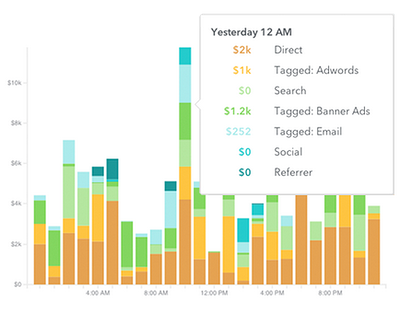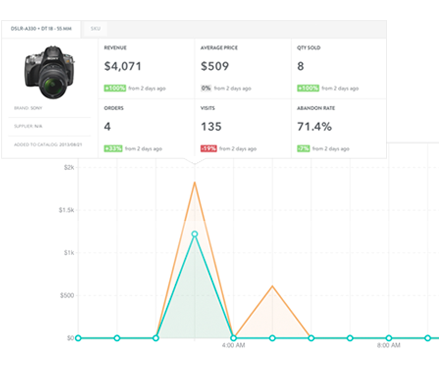A Guide To eCommerce Analytics For All Online Businesses
As the digital marketing space shifts, so do the technologies, tactics and services that industry professionals use. One tool that will stand the test of time for business owners to utilize to make better-informed decisions and ultimately measure the success of their company is analytics.
Businesses thrive using eCommerce analytics tools like BigCommerce Insights to look at year over year, even quarter over quarter, to see growth patterns for emerging industries and to better predict marketplace viability.
In other words, today’s data-driven decision making is beaconed by more objectivity than gut reaction — and that’s a good thing.
However, having access to any type of analytics tools doesn’t mean you know exactly what to look for to measure success for your business.
When it comes to which eCommerce metrics you need to know and measure, here’s a quick hit list of what is what when it comes to online shopping and your business.
eCommerce Analytics Overview
Cost of acquiring customer (CAC)
The amount of money you spend to get one customer is an important metric to start with. Why? This metric can help determine a company’s profitability by understanding the difference between how much money can be obtained from customers and the costs of obtaining it.
You may employ different techniques to bring in those visitors — SEO, paid ad campaigns, high-quality content, social media — but all of them cost you either in terms of time or in terms of money.
There are a lot of factors that affect your cost of customer acquisition, such as Average Order Value (AOV) and lifetime value, but it is important to get an accurate number here. As a best practice, you should always try to find marketing outlets that lower your CAC valuation.
To best determine which outlets maximize your marketing budget and efforts, you’ll want to use UTM tags (simple code you add to a custom URL to track a source, medium and campaign name) and analytics that measure from which sources traffic is being referred and at which times of day, and then measure it all over the course of a month or more.
Here’s what it looks like on the backend of BigCommerce:

In a view like this, you can clearly see the cost of acquisition per customer per channel varied depending on the time of day, day of week and week of month.
BigCommerce Insights also provides information on the best products for repeat purchase and the repeat purchase rate to give you insight on how to spend your marketing dollars on nurturing repeat customers.
Find which metrics prove to be the lowest cost while maintaining high acquisition, and you’ve optimized your marketing budget and strategy, allowing your ads to appear to your ideal customer at their ideal time for your ideal price point.
Conversion rate (CVR)
Conversion rate is defined as the percentage of visitors who end up buying from your store. When it comes to CR, you always want it to be going up.
According to this recent Marketing Land article, one way to improve CR is to add video to a majority of your product pages; retailers adding video reported CRs close to 9%, as opposed to those with video on fewer than half of their product pages.
There are hundreds of articles out there on how to improve CRs — because it is just that important. There’s so much emphasis on CR because it directly affects your business’s bottom line.
Regardless of how much effort you spend on driving traffic to your store, if most visitors don’t end up buying, it’s all wasted. That said, it’s really important to make sure you know what your CR is at all times and keep tabs on whether it’s improving and if you should stay the course or not.
Analytics can further drive up your CR by helping you to visualize which items on your site are best sellers depending on the time of day.

This will allow you to optimize your pricing strategies, generating higher margins from each individual conversion on high-selling items and pulling in increased conversions on low-selling items to rid you of the inventory.
Shopping cart abandonment
How many people are placing your products into carts and then leaving them? This is definitely something every business should want to know.
Shopping cart abandonment is the closest you come to earning real customers before they leave your site. Adding to the cart typically indicates intent to purchase. The fact that they leave without buying means you lost potential customers. It gets especially bad if you paid a lot of money to get these visitors to your store. Reducing your cart abandonment rate is key to improving your CR.
Good analytics tools will provide the following information regarding your abandoned cart rates:
- Abandoned Revenue – Amount of additional revenue that could be realized if all abandoned carts were completed orders. Calculated as the sum of all abandoned carts.
- Abandoned Carts – Total number of carts that did not result in an order.
- Abandon Rate – Percentage of carts that did not result in an order.
- Total Revenue – Total revenue from orders that were completed.
- Orders – Total number of carts that resulted in a completed order.
With this data, you will be armed to set up abandoned cart emails to A/B test which emails pull back an increased amount of customers. Abandoned cart emails are proven to bring back at least 10% of your abandoned sales.
Further, this data will also alert you to trends among which of your products get abandoned in cart most often. At this point, you can dive into why that might be. Are you including a surprise shipping charge for this item? Is this item easily breakable during shipping? What is the ultimate cause for such a high abandoned cart on these items?

Once you figure that out, you’ll be able to fix the issue or find new products to reduce your abandoned cart rate and increase store revenue.
Average order value (AOV)
This is the average size of an order from your store. The higher the AOV, the better.

By monitoring AOV, you can figure out how much revenue you can generate from your current traffic and conversion rate. Being able to predict revenue is a big deal for any business. If most of your orders are really small, that means you have to get a lot more people to buy in order to achieve your target. It’s important to have at least a few high value orders so that your overall average is on the higher side.
What’s more is that with advanced eCommerce analytics, you will be able to divide your customer base out by their AOV. In doing this, you can be sure to send new product emails to all those customers who often purchase at full price, and discount emails to those who typically only purchase sale items.

This strategy allows you to personalize your store experience for customers based on their shopping habits and preferences, as well as helps you to increase conversions for full-priced items and maintain high customer lifetime value.
Key takeaways
In order to understand what these metrics mean to you, you must be able to answer one of the oldest business questions in history: Who are you?
Knowing whether your business sells quick purchase products (gifts like chocolate or flowers) or considered goods (luxury products such as sports equipment) changes how you look at the health of your business and strategize ways in which to increase conversions, customer loyalty and overall revenue.
For more information on how you can get these analytics, check out BigCommerce Insights.



